Abstract
Prior physiological studies have suggested that parasympathetic control is altered in heart failure. The goal of our studies was to investigate the influence of heart failure on the muscarinic receptor, and its coupling to adenylate cyclase. Ligand binding studies using [3H]quinuclidinyl benzilate and enriched left ventricular (LV) sarcolemma, demonstrated that muscarinic receptor density in heart failure declined 36% from a control of 5.6 +/- 0.6 pmol/mg, with no change in antagonist affinity. However, agonist competition studies with both carbachol and oxotremorine showed that it was a loss of high affinity agonist binding sites in the sarcolemma from failing LV that accounted for this difference. The functional efficacy of the muscarinic receptor was also examined. When 1 microM methacholine was added to 0.1 mM GTP and 0.1 mM isoproterenol, adenylate cyclase stimulated activity was inhibited by 15% in normal LV but only 5% in LV sarcolemma from animals with heart failure even when the reduced adenylate cyclase in these heart failure animals was taken into account. Even at 100-fold greater concentrations of methacholine, significantly less inhibition of adenylate cyclase activity was observed in LV failure as compared with normal LV sarcolemma. Levels of the GTP-inhibitory protein known to couple the muscarinic receptor to adenylate cyclase, as measured with pertussis toxin labeling, were not depressed in LV failure. Thus, the inhibitory pathway regulating LV adenylate cyclase activity is defective in heart failure. The decrease in muscarinic receptor density, and in particular the specific loss of the high affinity agonist binding component of this receptor population, appears to be the major factor underlying this abnormality.
Full text
PDF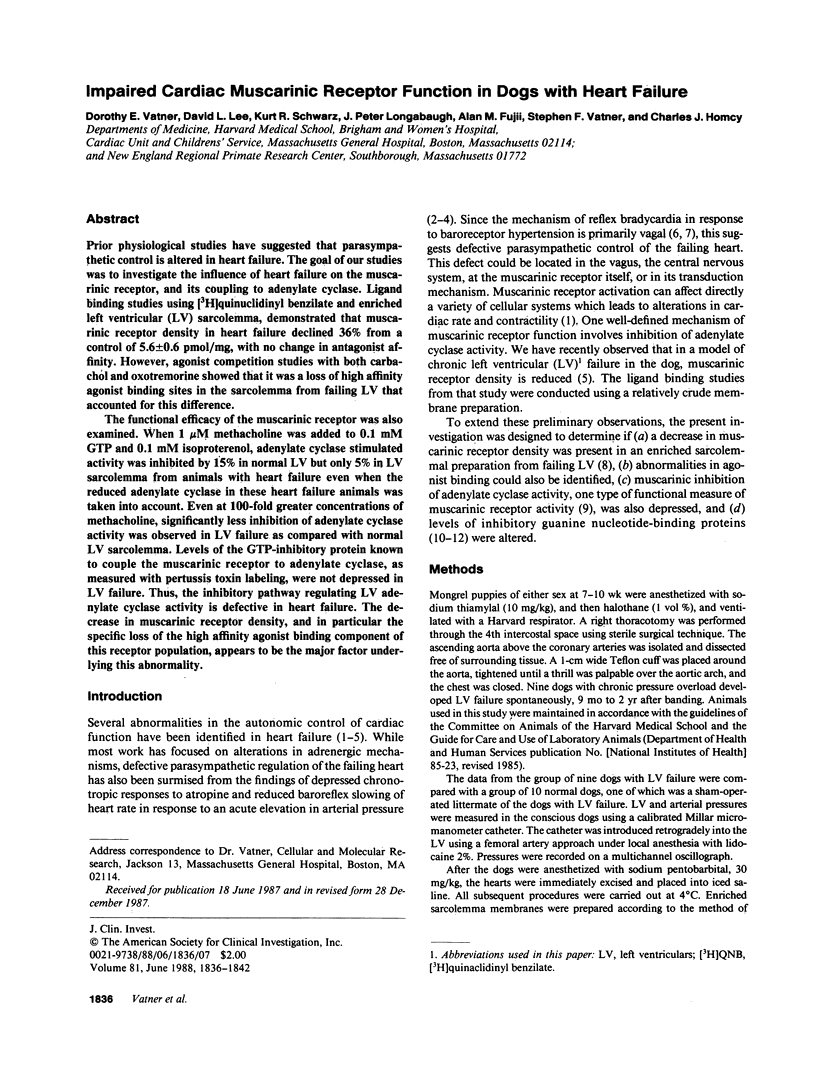
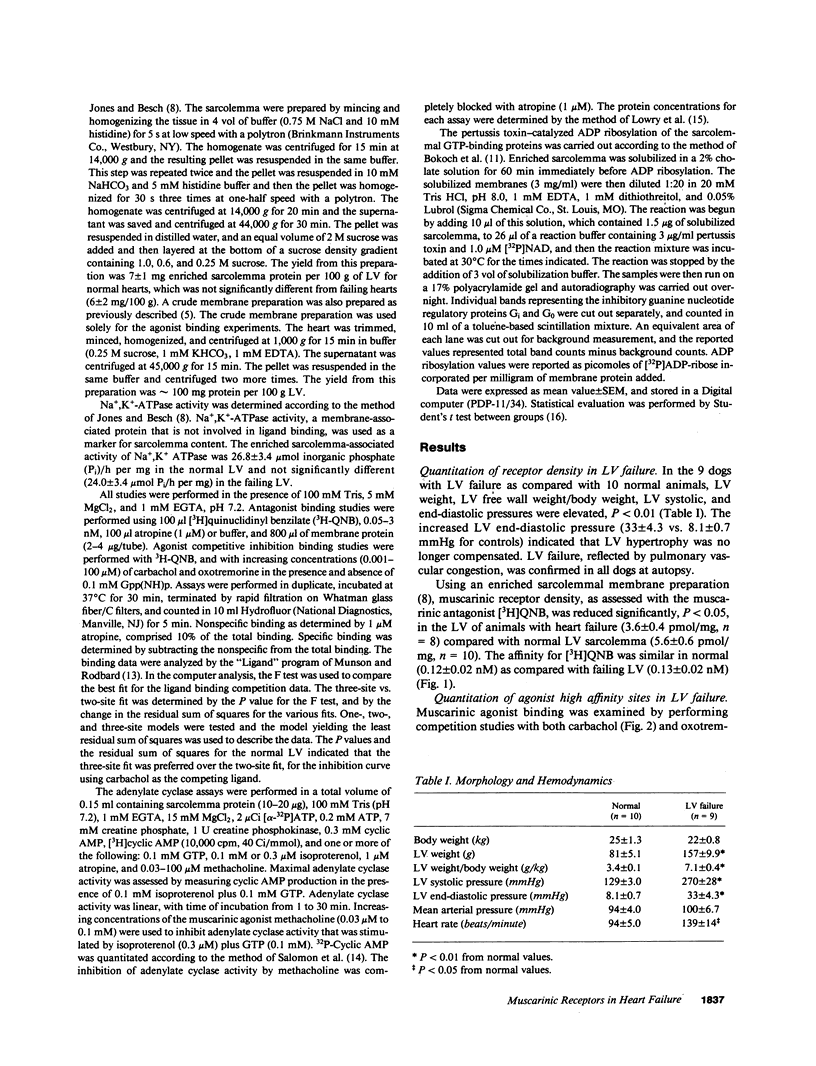
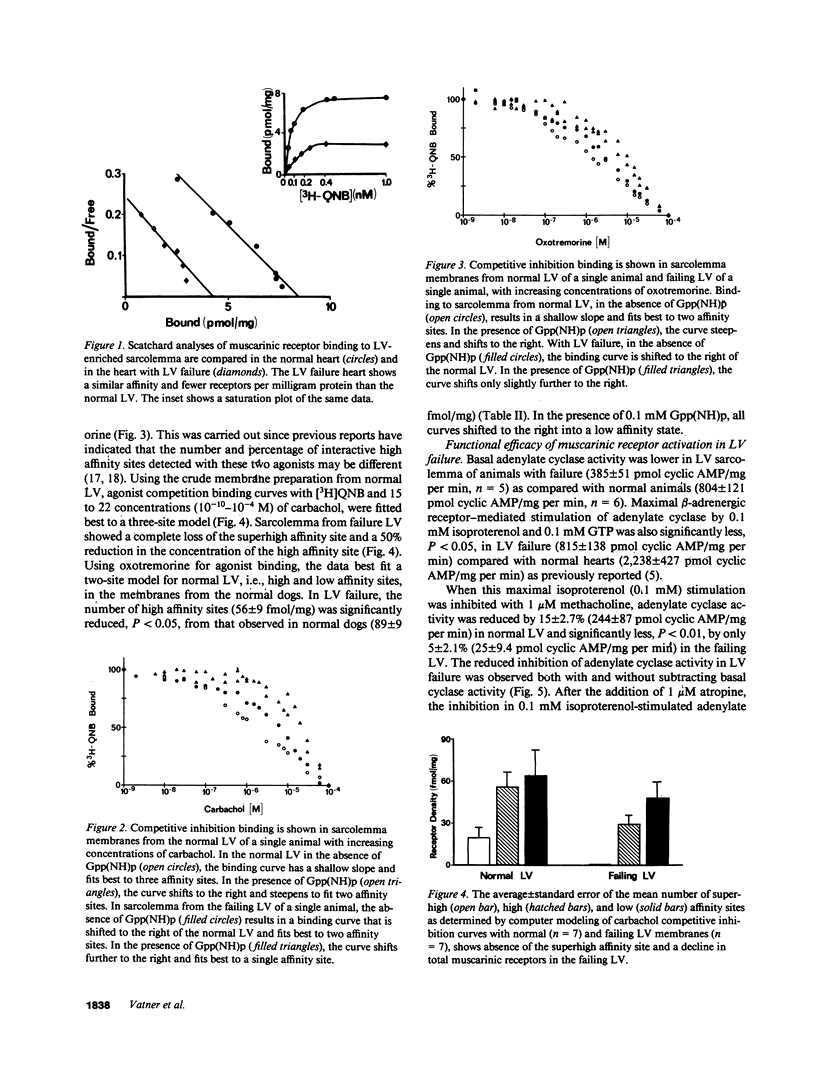
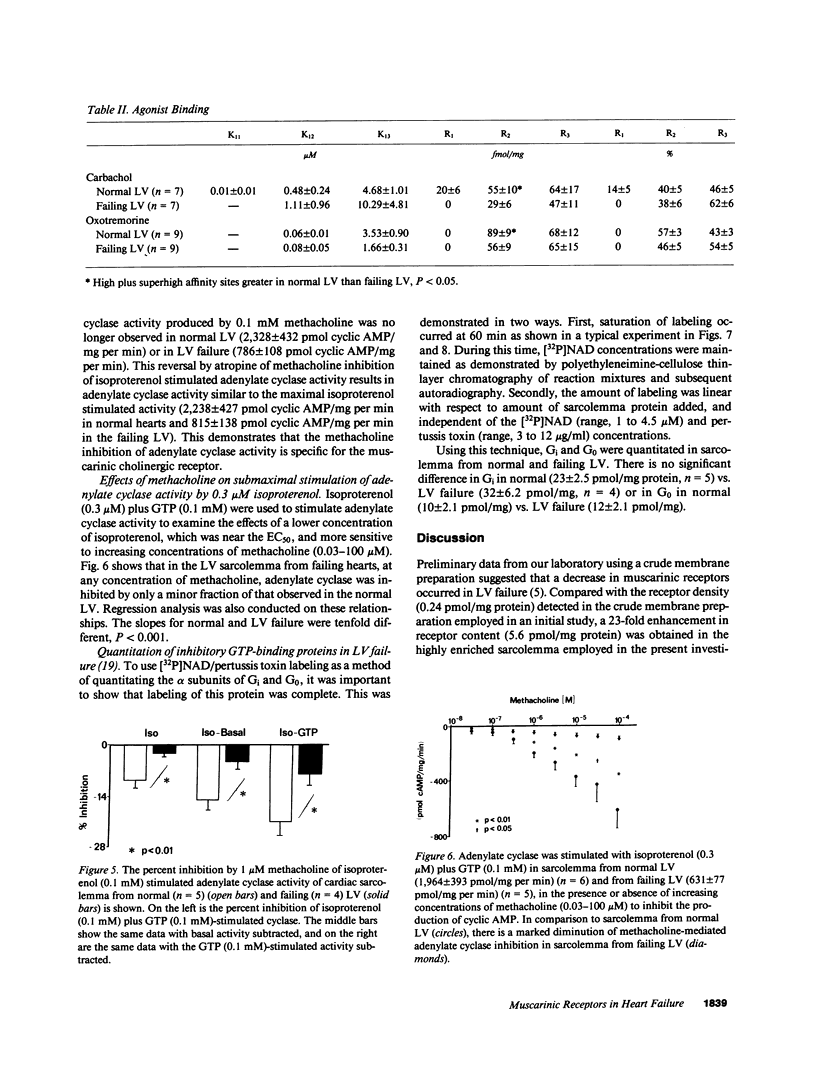
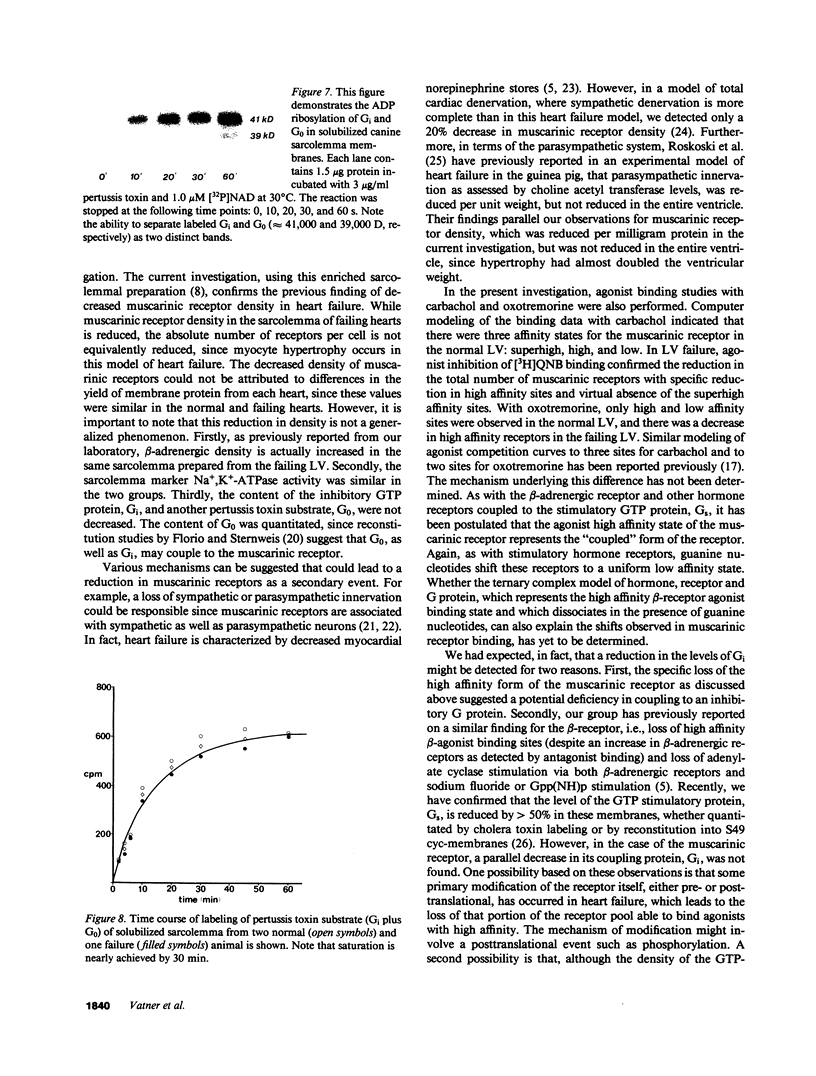
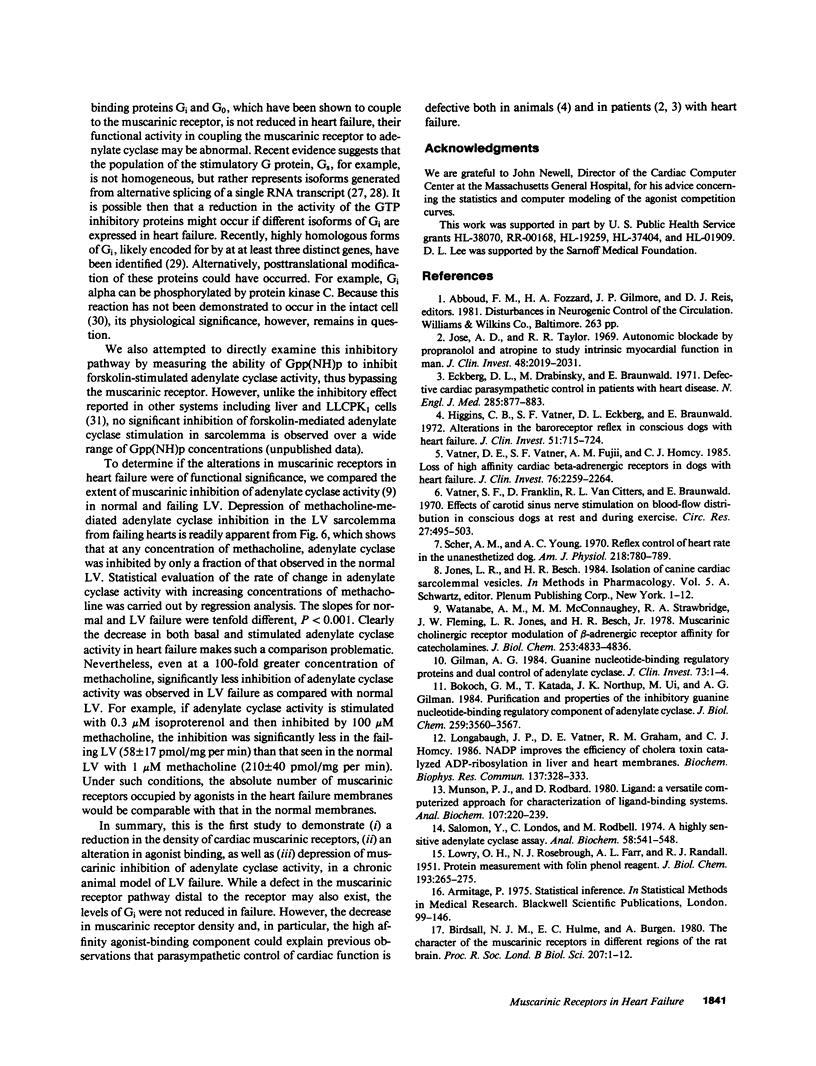
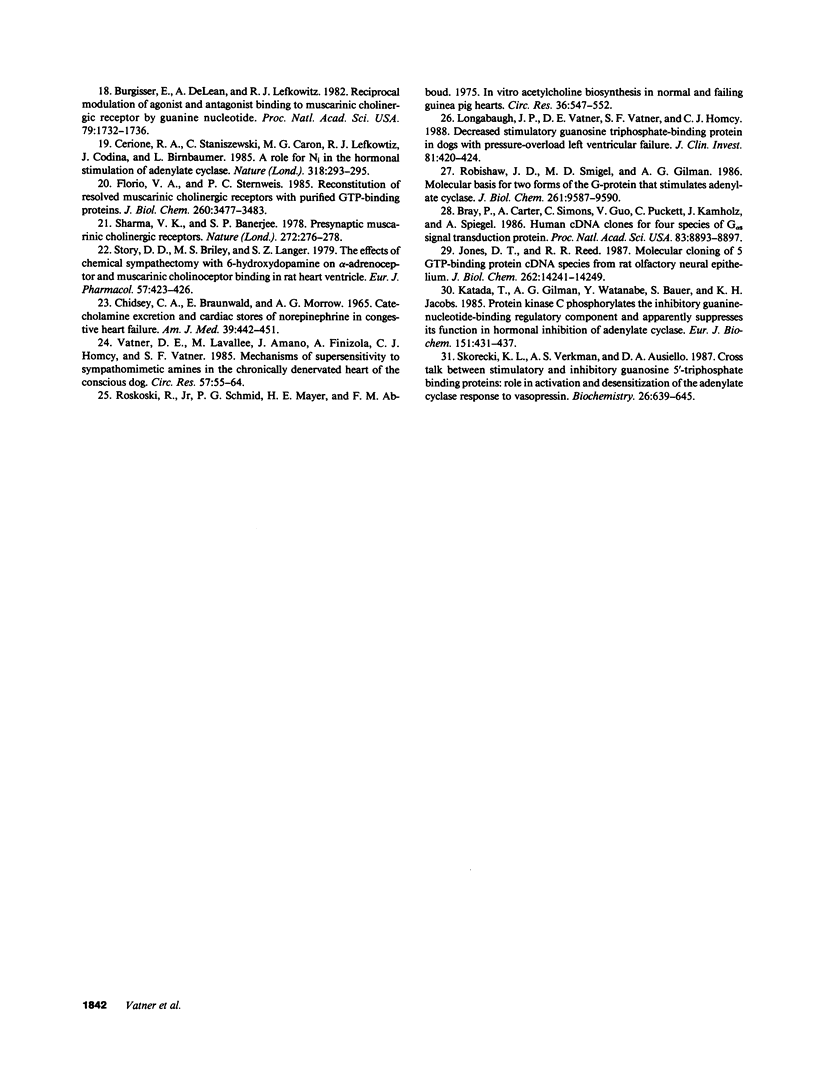
Images in this article
Selected References
These references are in PubMed. This may not be the complete list of references from this article.
- Birdsall N. J., Hulme E. C., Burgen A. The character of the muscarinic receptors in different regions of the rat brain. Proc R Soc Lond B Biol Sci. 1980 Feb 13;207(1166):1–12. doi: 10.1098/rspb.1980.0011. [DOI] [PubMed] [Google Scholar]
- Bokoch G. M., Katada T., Northup J. K., Ui M., Gilman A. G. Purification and properties of the inhibitory guanine nucleotide-binding regulatory component of adenylate cyclase. J Biol Chem. 1984 Mar 25;259(6):3560–3567. [PubMed] [Google Scholar]
- Bray P., Carter A., Simons C., Guo V., Puckett C., Kamholz J., Spiegel A., Nirenberg M. Human cDNA clones for four species of G alpha s signal transduction protein. Proc Natl Acad Sci U S A. 1986 Dec;83(23):8893–8897. doi: 10.1073/pnas.83.23.8893. [DOI] [PMC free article] [PubMed] [Google Scholar]
- Burgisser E., De Lean A., Lefkowitz R. J. Reciprocal modulation of agonist and antagonist binding to muscarinic cholinergic receptor by guanine nucleotide. Proc Natl Acad Sci U S A. 1982 Mar;79(6):1732–1736. doi: 10.1073/pnas.79.6.1732. [DOI] [PMC free article] [PubMed] [Google Scholar]
- CHIDSEY C. A., BRAUNWALD E., MORROW A. G. CATECHOLAMINE EXCRETION AND CARDIAC STORES OF NOREPINEPHRINE IN CONGESTIVE HEART FAILURE. Am J Med. 1965 Sep;39:442–451. doi: 10.1016/0002-9343(65)90211-1. [DOI] [PubMed] [Google Scholar]
- Cerione R. A., Staniszewski C., Caron M. G., Lefkowitz R. J., Codina J., Birnbaumer L. A role for Ni in the hormonal stimulation of adenylate cyclase. Nature. 1985 Nov 21;318(6043):293–295. doi: 10.1038/318293a0. [DOI] [PubMed] [Google Scholar]
- Eckberg D. L., Drabinsky M., Braunwald E. Defective cardiac parasympathetic control in patients with heart disease. N Engl J Med. 1971 Oct 14;285(16):877–883. doi: 10.1056/NEJM197110142851602. [DOI] [PubMed] [Google Scholar]
- Florio V. A., Sternweis P. C. Reconstitution of resolved muscarinic cholinergic receptors with purified GTP-binding proteins. J Biol Chem. 1985 Mar 25;260(6):3477–3483. [PubMed] [Google Scholar]
- Gilman A. G. Guanine nucleotide-binding regulatory proteins and dual control of adenylate cyclase. J Clin Invest. 1984 Jan;73(1):1–4. doi: 10.1172/JCI111179. [DOI] [PMC free article] [PubMed] [Google Scholar]
- Higgins C. B., Vatner S. F., Eckberg D. L., Braunwald E. Alterations in the baroreceptor reflex in conscious dogs with heart failure. J Clin Invest. 1972 Apr;51(4):715–724. doi: 10.1172/JCI106865. [DOI] [PMC free article] [PubMed] [Google Scholar]
- Jones D. T., Reed R. R. Molecular cloning of five GTP-binding protein cDNA species from rat olfactory neuroepithelium. J Biol Chem. 1987 Oct 15;262(29):14241–14249. [PubMed] [Google Scholar]
- Jose A. D., Taylor R. R. Autonomic blockade by propranolol and atropine to study intrinsic myocardial function in man. J Clin Invest. 1969 Nov;48(11):2019–2031. doi: 10.1172/JCI106167. [DOI] [PMC free article] [PubMed] [Google Scholar]
- Katada T., Gilman A. G., Watanabe Y., Bauer S., Jakobs K. H. Protein kinase C phosphorylates the inhibitory guanine-nucleotide-binding regulatory component and apparently suppresses its function in hormonal inhibition of adenylate cyclase. Eur J Biochem. 1985 Sep 2;151(2):431–437. doi: 10.1111/j.1432-1033.1985.tb09120.x. [DOI] [PubMed] [Google Scholar]
- LOWRY O. H., ROSEBROUGH N. J., FARR A. L., RANDALL R. J. Protein measurement with the Folin phenol reagent. J Biol Chem. 1951 Nov;193(1):265–275. [PubMed] [Google Scholar]
- Longabaugh J. P., Vatner D. E., Graham R. M., Homcy C. J. NADP improves the efficiency of cholera toxin catalyzed ADP-ribosylation in liver and heart membranes. Biochem Biophys Res Commun. 1986 May 29;137(1):328–333. doi: 10.1016/0006-291x(86)91214-3. [DOI] [PubMed] [Google Scholar]
- Longabaugh J. P., Vatner D. E., Vatner S. F., Homcy C. J. Decreased stimulatory guanosine triphosphate binding protein in dogs with pressure-overload left ventricular failure. J Clin Invest. 1988 Feb;81(2):420–424. doi: 10.1172/JCI113335. [DOI] [PMC free article] [PubMed] [Google Scholar]
- Munson P. J., Rodbard D. Ligand: a versatile computerized approach for characterization of ligand-binding systems. Anal Biochem. 1980 Sep 1;107(1):220–239. doi: 10.1016/0003-2697(80)90515-1. [DOI] [PubMed] [Google Scholar]
- Robishaw J. D., Smigel M. D., Gilman A. G. Molecular basis for two forms of the G protein that stimulates adenylate cyclase. J Biol Chem. 1986 Jul 25;261(21):9587–9590. [PubMed] [Google Scholar]
- Roskoski R., Jr, Schmid P. G., Mayer H. E., Abboud F. M. In vitro acetylcholine biosynthesis in normal and failing guinea pig hearts. Circ Res. 1975 Apr;36(4):547–552. doi: 10.1161/01.res.36.4.547. [DOI] [PubMed] [Google Scholar]
- Salomon Y., Londos C., Rodbell M. A highly sensitive adenylate cyclase assay. Anal Biochem. 1974 Apr;58(2):541–548. doi: 10.1016/0003-2697(74)90222-x. [DOI] [PubMed] [Google Scholar]
- Scher A. M., Young A. C. Reflex control of heart rate in the unanesthetized dog. Am J Physiol. 1970 Mar;218(3):780–789. doi: 10.1152/ajplegacy.1970.218.3.780. [DOI] [PubMed] [Google Scholar]
- Sharma V. K., Banerjee S. P. Presynaptic muscarinic cholinergic receptors. Nature. 1978 Mar 16;272(5650):276–278. doi: 10.1038/272276a0. [DOI] [PubMed] [Google Scholar]
- Skorecki K. L., Verkman A. S., Ausiello D. A. Cross talk between stimulatory and inhibitory guanosine 5'-triphosphate binding proteins: role in activation and desensitization of the adenylate cyclase response to vasopressin. Biochemistry. 1987 Jan 27;26(2):639–645. doi: 10.1021/bi00376a040. [DOI] [PubMed] [Google Scholar]
- Story D. D., Briley M. S., Langer S. Z. The effects of chemical sympathectomy with 6-hydroxydopamine on alpha-adrenoceptor and muscarinic cholinoceptor binding in rat heart ventricle. Eur J Pharmacol. 1979 Aug 15;57(4):423–426. doi: 10.1016/0014-2999(79)90505-3. [DOI] [PubMed] [Google Scholar]
- Vatner D. E., Lavallee M., Amano J., Finizola A., Homcy C. J., Vatner S. F. Mechanisms of supersensitivity to sympathomimetic amines in the chronically denervated heart of the conscious dog. Circ Res. 1985 Jul;57(1):55–64. doi: 10.1161/01.res.57.1.55. [DOI] [PubMed] [Google Scholar]
- Vatner D. E., Vatner S. F., Fujii A. M., Homcy C. J. Loss of high affinity cardiac beta adrenergic receptors in dogs with heart failure. J Clin Invest. 1985 Dec;76(6):2259–2264. doi: 10.1172/JCI112235. [DOI] [PMC free article] [PubMed] [Google Scholar]
- Vatner S. F., Franklin D., Van Citters R. L., Braunwald E. Effects of carotid sinus nerve stimulation on blood-flow distribution in conscious dogs at rest and during exercise. Circ Res. 1970 Oct;27(4):495–503. doi: 10.1161/01.res.27.4.495. [DOI] [PubMed] [Google Scholar]
- Watanabe A. M., McConnaughey M. M., Strawbridge R. A., Fleming J. W., Jones L. R., Besch H. R., Jr Muscarinic cholinergic receptor modulation of beta-adrenergic receptor affinity for catecholamines. J Biol Chem. 1978 Jul 25;253(14):4833–4836. [PubMed] [Google Scholar]



